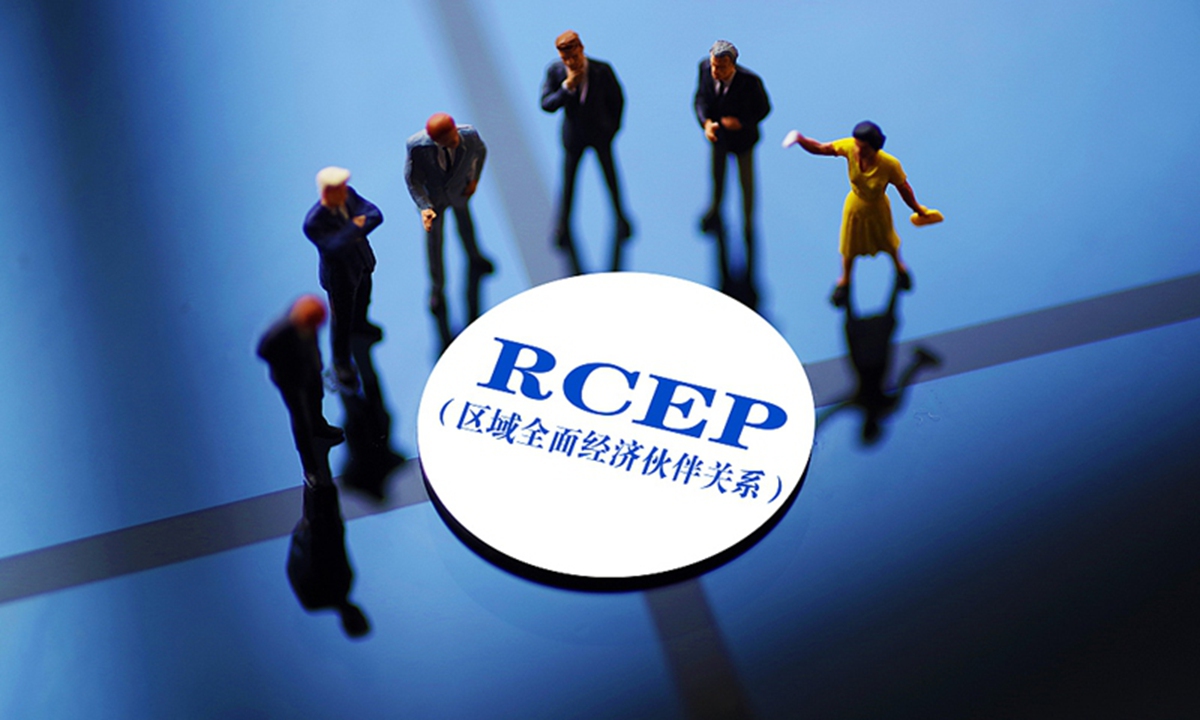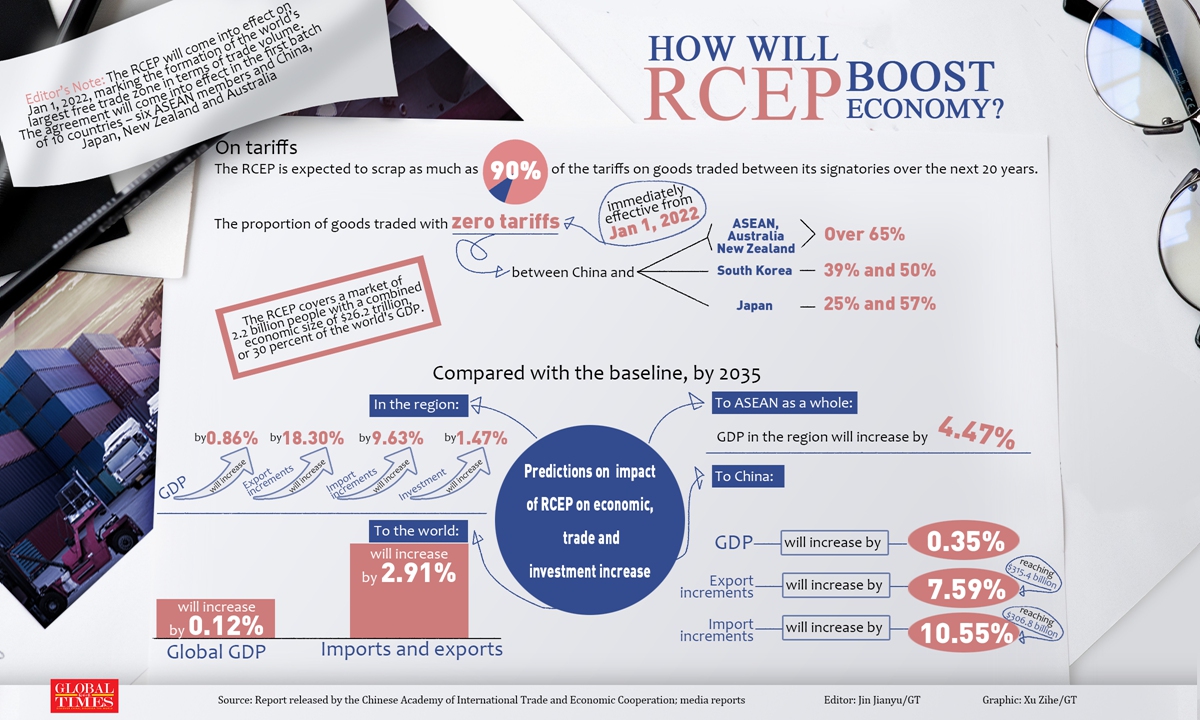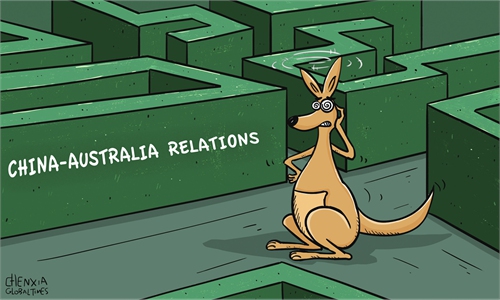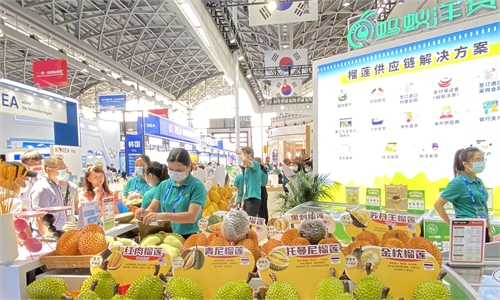Full ratification of RCEP expected in near future as mega trade deal manifests as linchpin for global growth
Trade bloc to play role as a global growth stabilizer, in contrast to 'empty' IPEF

RCEP Photo: Xinhua
The Regional Comprehensive Economic Partnership (RCEP), which has come into force for the majority of its 15 member countries, is expected to be fully ratified in the near future, trade body leaders disclosed during the ongoing China-ASEAN Expo (CAEXPO), the first edition of the annual event since the RCEP was implemented.
More than eight months into the implementation of the mega deal, its members, notably China, have strived for a galaxy of businesses in the Asia-Pacific region to tap into RCEP-enabled opportunities, according to key takeaways from the CAEXPO in Nanning, capital of South China's Guangxi Zhuang Autonomous Region, where government officials and trade experts alike urged more efforts to familiarize businesses with RCEP rules.
On that premise, the world's largest trading bloc is already evidently shining in a faltering global economy, CAEXPO participants stressed, citing figures that reveal the huge deal as a pronounced silver lining amid unsettling global growth outlooks, the ongoing pandemic and geopolitical strains.
The trade pact's notable progress and its vast untapped potential are considered proof of the RCEP's role as a global growth stabilizer, especially when compared with new economic initiatives such as Washington-launched Indo-Pacific Economic Framework for Prosperity (IPEF) that seem to be politically motivated empty shells, trade experts said.
RCEP gains steam
The colossal trade deal is expected to make significant headway in the foreseeable future, according to attendees of the annual trade fair. It is hoped the RCEP will enable brisker trade growth and closer economic ties among its member countries, they said.
In virtual remarks to a special dialogue on RCEP business cooperation during the CAEXPO on Saturday, Airlangga Hartarto, Indonesian Coordinating Minister for Economic Affairs, said that Indonesia ratified the RCEP on August 30 and will implement it in due time.
The trade pact, encompassing roughly one-third of the world's GDP, came into force for 10 countries including China on January 1. It took effect for South Korea on February 1 and for Malaysia on March 18. According to Chinese customs, the deal was also effective for Myanmar on May 1.
"So far as I know, the Philippines is supposed to soon complete its domestic approval procedures. I believe that the RCEP is set to embrace [its] implementation 'family photographing' in the near future, a day worth celebrating," Zhang Shaogang, vice chairman of the China Council for the Promotion of International Trade (CCPIT), told the same CAEXPO sub-event.
It is looking very promising that the RCEP will be fully ratified by all its members by the end of the year, Xu Ninging, executive president of the China-ASEAN Business Council, said in an interview with the Global Times during the CAEXPO.
Xu, also chairman of the RCEP Industry Cooperation Committee, recently had a meeting with the Philippine trade and industry department where the Southeast Asian country authorities pledged to push its parliament to ratify the RCEP as soon as possible.
A report on the ASEAN business environment was unveiled during the annual expo on Saturday, which said that individual ASEAN members have not completed the RCEP domestic approval process, resulting in high market access barriers.
The deal's anticipated final ratification is expected to encourage more businesses in the trading bloc into jumping on the RCEP bandwagon.
China is spearheading regional efforts to render the RCEP a readily available free trade apparatus for domestic businesses.
In the first eight months, the CCPIT has directly hosted and indirectly offered guidance on hundreds of training sessions tailored for deal implementation, according to Zhang.
The training sessions are part of the trade body's endeavor to address businesses' concerns over how to benefit from RCEP rules, he said, citing confusion about the RCEP's cumulative rules of origin as one of the major perplexities confronting the business community.
The rules, billed as the biggest gain under the RCEP framework, allows inputs from the bloc to be counted as local when produced in a RCEP member, thereby harmonizing the rules of origin and lowering trade costs.
In an attempt to genuinely translate RCEP rules into commercial benefits endowed to a multitude of firms, the CCPIT has plans to arrange more specific training sessions for traders to capitalize on industry-tailored preferential tax rates under the deal, Zhang revealed.
It is imperative to educate traders on RCEP rules and their application, Xu told the Global Times, speaking of the untapped potential of pressing ahead with the deal implementation.
National-level industry bodies and associations ought to come up with action plans to supervise businesses' alignment of their operations and strategies with the deal, he advised, voicing optimism that China is better placed to implement the RCEP than other members.
He cited the country's effective epidemic containment that paves the way for its deal implementation while other members still struggle with the still-raging pandemic.
Additionally, the country's institutional advantages warrant efficient implementation, he continued, noting that China's success in acquainting its business community with WTO rules over the years heralds the RCEP's effective implementation on a wider scale in years to come.
In the case of South Korea, Ko Beomseo, chief representative of the Chengdu Representative Office of the Korea International Trade Association (KITA), revealed during the CAEXPO that there are 18 application centers within South Korea and nine such centers outside the country where businesses can get consulting services on free trade agreements and the RCEP in particular.

The RCEP will come into effect on Jan 1, 2022, marking the formation of the world's largest free trade zone in terms of trade volume. The agreement will come into effect in the first batch of 10 countries - six ASEAN members and China, Japan, New Zealand and Australia. Graphic: Xu Zihe/GT
Linchpin for global growthBroad-based efforts to ramp up the deal implementation are seen as offering a much-needed dose of reassurance amid woes over lackluster growth globally.
"All countries now have to get their economies back on their feet and [the] RCEP focuses on two things, which [are] to reduce tariffs, as well as to facilitate trade. It has a very important role to play," Malaysian Ambassador to China Raja Dato' Nushirwan Zainal Abidin told the Global Times on the sidelines of the expo over the weekend.
Studies by ASEAN show that Malaysia is likely to benefit the most from the RCEP and the benefit is likely to hit $200 million, the ambassador said.
A fresh example of RCEP-enabled opportunities was the signing of a $326 million project during the CAEXPO over the weekend - the Malaysia-China Kuantan International Logistics Park.
Malaysia's economy expanded by 8.9 percent in the second quarter, official data showed, beating market estimates.
Other fast-growing economies in the region include Vietnam which recorded 7.7 percent in second-quarter GDP growth, and the Philippines whose economy grew by 7.4 percent during the second quarter.
In the words of Xu, the RCEP bloc is arguably the brightest spot across the globe in terms of economic growth and multinationals would surely look to the region for business opportunities along with the deal's full ratification.
In a sign that RCEP-induced gains that bucked the overall downward spiral, particularly in the US and Europe where local growth is being threatened by soaring inflation and energy crises, China's imports and exports with other RCEP countries soared 18.8 percent in yuan terms in July alone, driving overall trade growth by 5.6 percentage points, per Chinese customs data.
This year's CAEXPO also bears witness to the RCEP's trade clout. Twenty investment projects involving RCEP members were signed at the expo where a total of 267 projects were inked with investments amounting to 413 billion yuan ($59.14 billion), an increase of 37 percent from the year before and an all-time high on the expo's record, the CAEXPO's secretariat revealed on Friday.
The tangible benefits attest to the mega deal's role as ballast to lead global growth, setting it apart from other so-called RCEP rivals, observers emphasized. One of the alleged lookalikes is the 14-member IPEF, only launched in May, whose membership partially overlaps with that of the RCEP.
The IPEF is essentially the economic component of the US' Indo-Pacific strategy and the politically motivated framework is more paying lip service that guarantees no substantial benefits, Xu remarked, arguing against shockwaves through the RCEP in the wake of the IPEF's announcement.



